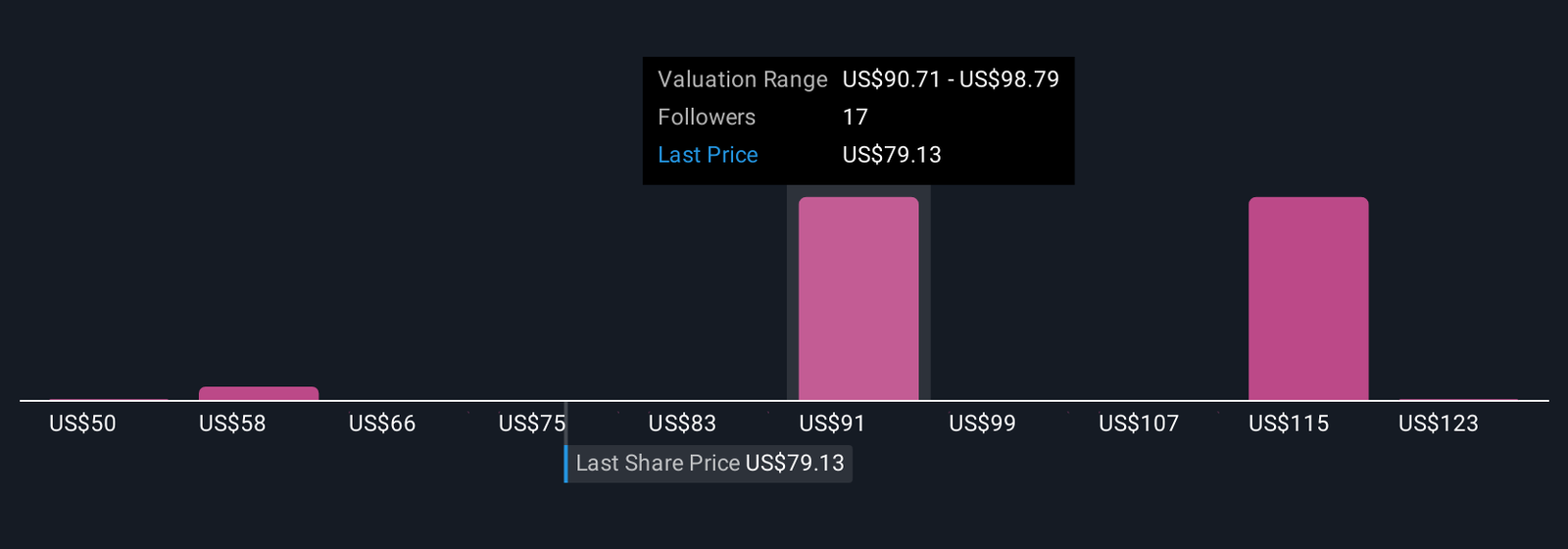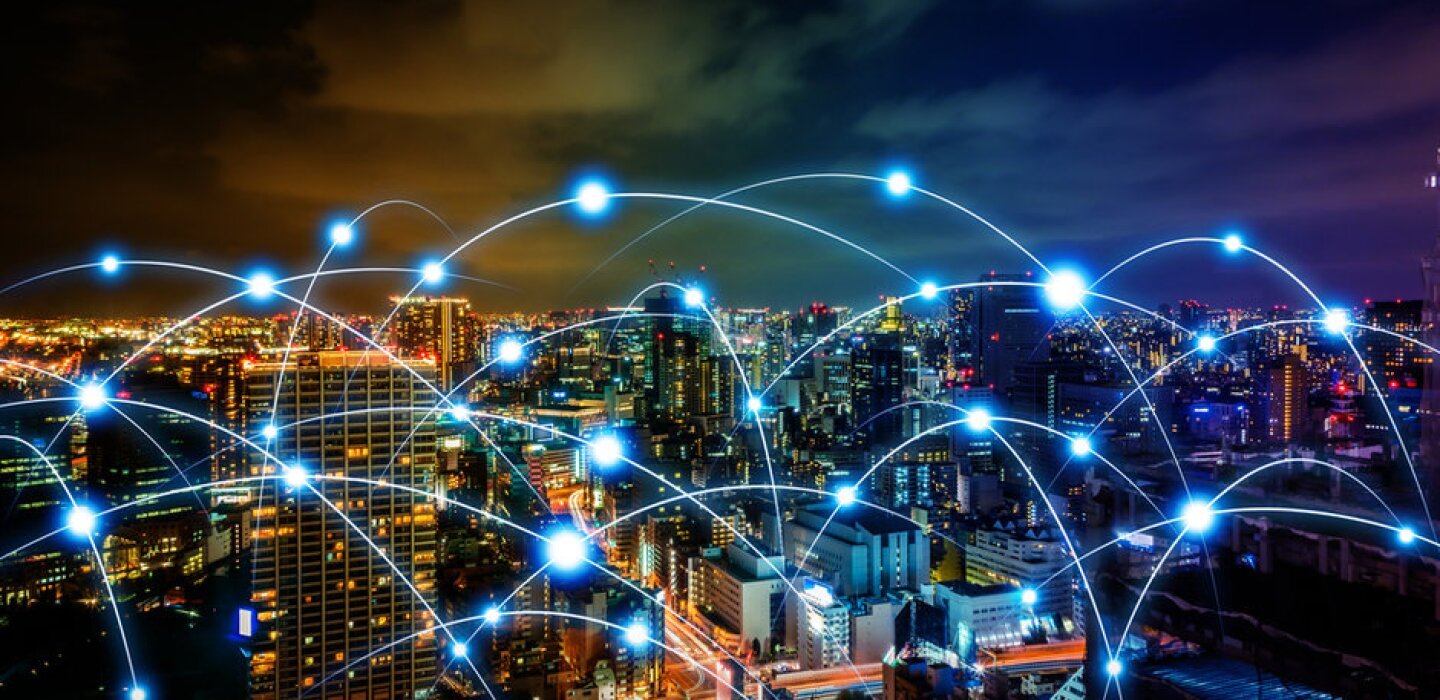Tools & Platforms
How New Cloud and AI Security Partnerships at Akamai Technologies (AKAM) Have Changed Its Investment Story

- On August 13, 2025, Aptum announced a new partnership with Akamai Technologies to deliver cloud migration and transformation services, while Akamai also revealed a collaboration with Aqua Security to bolster AI-powered cloud security for enterprise customers.
- These recent deals signal Akamai’s growing efforts to accelerate innovation in cloud and AI security, aligning its platform with evolving enterprise technology priorities.
- We’ll examine how Akamai’s expanded cloud services partnerships may influence its investment narrative and future growth outlook.
Explore 23 top quantum computing companies leading the revolution in next-gen technology and shaping the future with breakthroughs in quantum algorithms, superconducting qubits, and cutting-edge research.
Akamai Technologies Investment Narrative Recap
To be comfortable owning Akamai Technologies, investors must believe the company can offset secular declines in its legacy delivery business by scaling its cloud, compute, and security offerings quickly enough to drive sustained revenue and profit growth. The recent partnerships with Aptum and Aqua Security underscore Akamai’s intent to align its platform with rising AI and security demands, but they do not yet materially alter the short-term catalyst of accelerating cloud revenue or reduce the main risk of margin pressure from capital-intense expansion.
Among the latest developments, Akamai’s August 13 announcement with Aptum stands out, as it connects directly to the ongoing catalyst of expanding Cloud Infrastructure Services (CIS) revenue. By partnering to offer integrated cloud migration services, Akamai aims to deepen enterprise adoption of its cloud platform, which is essential for driving the top-line growth expected as part of its transformation story.
Yet, investors should not overlook that increasing capital expenditures to support these new cloud and AI initiatives could pressure net margins if scaling proves slower or costlier than anticipated…
Read the full narrative on Akamai Technologies (it’s free!)
Akamai Technologies’ narrative projects $4.9 billion in revenue and $765.1 million in earnings by 2028. This requires 6.1% yearly revenue growth and a $340.5 million earnings increase from $424.6 million currently.
Uncover how Akamai Technologies’ forecasts yield a $95.20 fair value, a 20% upside to its current price.
Exploring Other Perspectives
Six members of the Simply Wall St Community estimate Akamai’s fair value between US$50.32 and US$131.10 per share. While bullish cloud catalysts are top of mind, many investors continue to weigh margin and profitability risks before setting expectations for the company’s path forward.
Explore 6 other fair value estimates on Akamai Technologies – why the stock might be worth as much as 66% more than the current price!
Build Your Own Akamai Technologies Narrative
Disagree with existing narratives? Create your own in under 3 minutes – extraordinary investment returns rarely come from following the herd.
Contemplating Other Strategies?
Don’t miss your shot at the next 10-bagger. Our latest stock picks just dropped:
This article by Simply Wall St is general in nature. We provide commentary based on historical data
and analyst forecasts only using an unbiased methodology and our articles are not intended to be financial advice. It does not constitute a recommendation to buy or sell any stock, and does not take account of your objectives, or your
financial situation. We aim to bring you long-term focused analysis driven by fundamental data.
Note that our analysis may not factor in the latest price-sensitive company announcements or qualitative material.
Simply Wall St has no position in any stocks mentioned.
New: Manage All Your Stock Portfolios in One Place
We’ve created the ultimate portfolio companion for stock investors, and it’s free.
• Connect an unlimited number of Portfolios and see your total in one currency
• Be alerted to new Warning Signs or Risks via email or mobile
• Track the Fair Value of your stocks
Have feedback on this article? Concerned about the content? Get in touch with us directly. Alternatively, email editorial-team@simplywallst.com
Tools & Platforms
Half of firms lack AI expertise despite rising interest in EAM tech

A global survey of maintenance professionals has found that almost half of industrial businesses lack internal expertise to adopt advanced tools such as artificial intelligence.
The Ultimo Maintenance Trend Report, based on input from over 200 maintenance professionals worldwide, highlights how emerging technologies including AI, machine learning, and digital twins are increasingly being recognised as key enablers in enterprise asset management (EAM). The report also points to persistent workforce challenges and the important role of human skill in the successful implementation of these next-generation tools.
Shift to next-generation technologies
According to the survey, there has been a significant increase in interest in advanced technologies since the last Ultimo EAM Trend Report in 2023. When respondents were asked about which innovations they believe will have the most positive impact on their maintenance and business practices, contextual intelligence was cited by 68% of participants, markedly up from 8% one year earlier. Automation and robotics (49%) and machine learning (41%) were also highlighted as areas of strong interest. The proportion of professionals interested in digital twins has more than doubled, now reaching 40%.
Despite the interest in and potential benefits of these technologies, some significant barriers remain. The survey found that 49% of respondents lack the internal expertise necessary to implement advanced tools like AI and machine learning. For many organisations, this skills gap poses a key challenge to the wider adoption of digital technologies in industrial asset management.
Workforce challenges
The survey data also indicates that workforce issues continue to be a dominant concern. An aging workforce was identified as the most pressing trend impacting maintenance strategy by 63% of respondents, underlining the urgency of knowledge transfer and workforce planning for businesses in asset-heavy sectors. In parallel, 50% of participants stated that recruiting experienced staff was their primary source of disruption over the past year, suggesting that both immediate and long-term workforce needs are being keenly felt.
Insights from Ultimo
“From global instability to changing regulations, socio-economic and political shifts are creating uncertainty across industries. In this environment, agility is critical,” said Berend Booms, Head of EAM Insights at Ultimo, an IFS company. “EAM can also serve as a catalyst for innovation. Internet of Things (IoT), AI, ML, digital twins, and predictive analytics are rapidly transforming industrial businesses. They unlock smarter decision-making, greater efficiency, and a sharper competitive edge.”
Role of data and analytics in asset maintenance
The report further explores how increased availability of real-time data, enabled by technologies such as IoT and predictive analytics, is contributing to the evolution of EAM systems. The perceived impact of predictive modelling has tripled according to this year’s findings compared with the previous year’s survey. Yet, with 49% of businesses citing inadequate internal know-how as a limiting factor, practical uptake remains uneven across industries and markets.
Modern EAM systems have moved beyond solely serving as record-keeping tools. By integrating AI and maintenance data, these systems are now being used to produce actionable insights, helping maintenance teams anticipate needs and transition from reactive repairs to proactive strategies. This shift, according to the research, is enabling organisations to improve efficiency, reduce downtime, and derive greater value from their maintenance investments.
Ultimo has introduced AI-powered EAM features designed to be accessible and deployable without the need for in-house AI model development or significant infrastructure investments. These capabilities aim to lower adoption barriers and facilitate immediate operational improvements for asset-heavy enterprises.
The Maintenance Trend Report, which contains contributions from Verdantix, TwinThread, ABS Consulting, and MaxGrip, states that blending human expertise with intelligent systems is likely to be the most effective approach as businesses strive to enhance their asset maintenance functions. As noted in the report, technology alone does not provide a complete solution, but the combination of skilled professionals and advanced digital tools is shaping future directions in maintenance management.
The survey captured perspectives from professionals working in sectors including manufacturing, healthcare, energy, utilities, telecommunications, transportation, and logistics, across a wide range of company sizes. Respondents were drawn from Austria, Belgium, Czech Republic, Denmark, Finland, Germany, Iceland, Luxembourg, Netherlands, Norway, UK, USA, and Sweden.
Tools & Platforms
AI-Driven ‘Omni Cities’ Are the Way Forward

More than 100 people lost their lives in July when flash floods ravaged Central Texas, illustrating the devastation that’s possible when mounting natural disasters are met with inefficient government responses. Agencies operated in complete silos as the floods quickly destroyed communities — county emergency systems couldn’t share real-time data with state coordinators while rescue teams worked from incompatible dispatch networks — resulting in desolation that was completely amplified by the failure of civic communications technology.
Today, our cities and towns operate like 18th-century mansions rewired with modern gadgets: functional in calm weather, yet lethal in storms. And as climate disasters intensify, cyber warfare evolves and AI-powered threats emerge, the “smart city” model that promised efficiency through sensors and dashboards has proven dangerously inadequate in recent years.
The path forward is not more tech — it’s new architecture. We need cities that don’t just collect data, but process that data in real time to adapt, evolve and take action as unified living systems. They can’t just be “smart,” but instead must be “omni” cities: urban ecosystems with integrated AI nervous systems that coordinate every element of civic life with both precision and purpose.
THE FRAGMENTATION CRISIS
Today’s cities are digital archipelagos. A drone from one vendor can’t share data with a robot from another, while emergency systems speak different languages. This is not inefficiency, but a structural failure seen across virtually every U.S. metropolis.
This fragmentation has been our downfall during the greatest of tragedies. When Hurricane Helene struck in 2024, outdoor sirens stayed silent while cell networks collapsed — not because the technology failed, but because nothing was designed to work together. Several months later when California wildfires forced 200,000 evacuations earlier this year, communication breakdowns and uncoordinated shelters led to 31 preventable deaths.
Yet these communication issues are not isolated to climate disasters. In fact, they’re happening in small ways every day, from 911 dispatch failures to fractured public transport services. And as time passes, new threats are emerging faster than cities can adapt, from AI-powered cyber attacks targeting infrastructure vulnerabilities, to weaponized drone swarms exploiting communication gaps. Our fragmented civic networks don’t just lag behind these challenges — they amplify them.
BEYOND ‘SMART’: THE OMNI CITY VISION
Just as smart cities promised efficiency in the 2010s, omni cities will deliver the resilience needed to face the looming threats of the next decade.
As suggested by its name, an omni city operates as a unified organism in which every component shares a common protocol for crisis response. When a wildfire approaches an omni city, the city doesn’t just sound alarms — it automatically reroutes traffic, opens shelters and coordinates evacuation routes while emergency teams receive real-time data from every connected system.
This isn’t science fiction; cities like Houston are already testing integrated frameworks that link climate response, public safety and mobility systems. The difference of an omni city, however, lies in treating cities as ecosystems rather than collections of isolated smart devices.
The key is interoperability — not just between machines, but between machines and humans. This requires a city-scale operating system that allows autonomous tools, public responders and ethical protocols to work in lockstep. Instead of retrofitting isolated apps, this OS treats cities like systems, linking drones, sensors, robotics, transport and emergency teams through a unified protocol layer.
When cities become more intelligent, they must also become more accountable, particularly in regards to equity. The smart city movement failed in part because it prioritized convenience for the wealthy (or those who can access technology in the first place) over resilience for everyone. Omni cities must flip this model by prioritizing resilience testing in the places most vulnerable to system failures, with the communities that legacy infrastructure has consistently ignored. This isn’t charity, it’s engineering. Systems that can’t serve everyone can’t truly serve anyone.
THE MOMENT FOR ACTION
While exploring the next iteration of a “smart city” may feel daunting, local governments don’t need federal permission to begin. They can start by requiring interoperability standards for new public technology, creating transparent audit systems for automated decisions and prioritizing deployments in underserved communities. The goal isn’t to build perfect cities overnight, but to create the foundations for urban systems that can evolve with emerging challenges.
The era of omni cities begins with recognizing that in a world of cascading crises, our urban infrastructure must become our first responder. Cities that understand this won’t just survive — they’ll define what governance means in the age of artificial intelligence.
When infrastructure thinks as fast as threats emerge, resilience becomes possible. The question is not whether cities will evolve, but which ones will evolve first.
Cesar R. Hernandez is an Equity Fellow in the Center for Public Leadership at Harvard Kennedy School.
Tools & Platforms
Scale AI is suing a former employee and rival Mercor, alleging they tried to steal its biggest customers

Scale AI, which helps tech companies prepare data to train their AI models, filed a lawsuit against one of its former sales employees and its rival Mercor on Wednesday. The suit claims the employee, who was hired by Mercor, “stole more than 100 confidential documents concerning Scale’s customer strategies and other proprietary information,” according to a copy seen by TechCrunch.
Scale is suing Mercor for misappropriation of trade secrets and is suing the former employee, Eugene Ling, for breach of contract. The suit also claims the employee was trying to pitch Mercor to one of Scale’s largest customers before he officially left his former job. The suit calls this company “Customer A.”
Mercor co-founder Surya Midha denies that his company used any data from Scale, although he admits that Ling may have been in possession of some.
“While Mercor has hired many people who departed Scale, we have no interest in any of Scale’s trade secrets and in fact are intentionally running our business in a different way. Eugene informed us that he had old documents in a personal Google Drive, which we have never accessed and are now investigating,” Midha told TechCrunch in an emailed statement.
“We reached out to Scale six days ago offering to have Eugene destroy the files or reach a different resolution, and we are now awaiting their response,” Midha said.
Scale alleges that these documents contained the specific data that would allow Mercor to serve Customer A, as well as several other of Scale’s most important clients.
Scale wanted Mercor to give it a full list of the files in the drive, and to prevent Ling from working with Customer A. It alleges in the suit that Mercor refused. Ling did not immediately respond to TechCrunch’s request for comment.
Techcrunch event
San Francisco
|
October 27-29, 2025
There are scant clues in the suit about the identity of Customer A. The suit does say that if Scale’s rival did win this customer away, it would be a contract “worth millions of dollars to Mercor.”
Whatever the details of this suit, it does show one thing: Scale is clearly concerned enough about the threat of Mercor to pursue legal action. As TechCrunch previously reported, even with Meta’s multibillion-dollar investment into Scale, TBD Labs — the core unit within Meta tasked with building AI superintelligence — is still using Mercor and other LLM data training service providers.
Mercor is rising in the LLM training arena because it is known for hiring content specialists, often PhDs, to train LLM data in their areas of expertise.
In June, Scale announced that Meta was investing $14.3 billion for a 49% stake in Scale and was hiring away its founder. Shortly after that, several of Scale AI’s largest data customers, who are competitors to Meta’s efforts, reportedly cut ties with it.
-

 Business5 days ago
Business5 days agoThe Guardian view on Trump and the Fed: independence is no substitute for accountability | Editorial
-
Tools & Platforms3 weeks ago
Building Trust in Military AI Starts with Opening the Black Box – War on the Rocks
-

 Ethics & Policy1 month ago
Ethics & Policy1 month agoSDAIA Supports Saudi Arabia’s Leadership in Shaping Global AI Ethics, Policy, and Research – وكالة الأنباء السعودية
-

 Events & Conferences4 months ago
Events & Conferences4 months agoJourney to 1000 models: Scaling Instagram’s recommendation system
-

 Jobs & Careers2 months ago
Jobs & Careers2 months agoMumbai-based Perplexity Alternative Has 60k+ Users Without Funding
-

 Education2 months ago
Education2 months agoVEX Robotics launches AI-powered classroom robotics system
-

 Funding & Business2 months ago
Funding & Business2 months agoKayak and Expedia race to build AI travel agents that turn social posts into itineraries
-

 Podcasts & Talks2 months ago
Podcasts & Talks2 months agoHappy 4th of July! 🎆 Made with Veo 3 in Gemini
-

 Podcasts & Talks2 months ago
Podcasts & Talks2 months agoOpenAI 🤝 @teamganassi
-

 Education2 months ago
Education2 months agoAERDF highlights the latest PreK-12 discoveries and inventions

